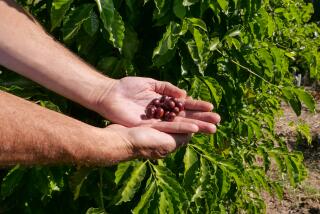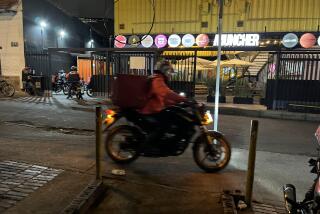Market Focus : Colombia Savors Taste of Its Coffee’s Success : Brazil, the longtime industry leader, is being pressed in its role as export king. Superior marketing and an excellent product are the key factors in Bogota’s progress.
BOGOTA, Colombia — Juan Valdez, Colombia’s symbolic Mr. Coffee, is symbolically counting his pesos with a warm glow of self-satisfaction, if not outright glee, these days.
The reason: In 1990 Colombia earned more from coffee exports than Brazil, the longtime titan of the international coffee market.
That’s big news here. “Colombia Defeated Brazil in Coffee,” boasted a Colombian newspaper headline when the news came out the other day. “Colombia, No. 1 World Coffee Exporter,” declared another.
Although the coffee picture is not entirely bright for this country, Juan Valdez has good reason to be pleased. He is the fictional hero in a true story of spectacular marketing success.
You know Juan Valdez--the mustachioed man with the sombrero and the burro who appears on commercials and coffee labels offering “100% Colombian Coffee. . . . The richest coffee in the world.”
It doesn’t matter that Juan Valdez is not really a Colombian coffee grower but the creation of the New York advertising firm, Doyle Dane Bernbach (now DDB Needham Worldwide, Inc.). By repetition over three decades, the symbolic character has become familiar to Americans and Europeans as the emblem of superior quality in Colombian coffee.
That emphasis on quality is the essence of the Colombian marketing strategy, a concept that coffee experts say is not mere advertising hype.
Consumer Reports, the American product-testing publication, reported in its January issue that of 23 ground coffees tested, 100% Colombian samples swept the top five places in the ratings.
The mild, arabica strain of coffee grown in Colombia is generally regarded as less bitter and more aromatic than most Brazilian arabicas. Colombians also say the mountain climate and soils of their coffee-growing areas, their hand-harvesting techniques and their method of washing off the coffee cherry’s hull all enhance their product’s taste.
So, although Brazil still exported more 132-pound bags of coffee than Colombia last year, Colombia’s earnings jumped ahead of Brazil’s, $1.5 billion to $1.3 billion.
The only other time Colombia out-earned Brazil was in 1986, when the Brazilians held back coffee exports as part of a failed effort to manipulate world prices.
Their success is reflected in the headquarters of the Coffee Growers Federation of Colombia--a red-brick, 12-story, two-tower office building on the upscale north side of Bogota. Outside the modern headquarters is a sign featuring--who else?--Juan Valdez, his burro and a jagged mountain peak. Inside is an elevator that calls out the floors in a recorded voice as it rises: Piso nueve, subiendo (9th floor, going up.)
On the 11th floor is Alvaro Sabogal, the federation’s advertising manager, whose pin-stripe suit and paisley tie speak of Madison Avenue. Sabogal speaks of success.
It all started in 1959, the year DDB brewed up the image of Juan Valdez.
“They started showing the situation of coffee growing in Colombia, using Juan Valdez,” Sabogal says. The mustachioed character was shown demonstrating how Colombian coffee beans were selected for ripeness, then picked by hand, then carefully processed.
The campaign aimed not only at consumers, with television spots on national networks, but also at institutional buyers, with ads in trade publications. Posters of some of those ads hang on the wall behind Sabogal’s desk.
“Colombian coffee is now being served in the starboard lounge,” says one of the posters. It shows an ocean liner listing to starboard.
“Captain, we forgot the Colombian coffee,” says another poster showing a jetliner doing a U-turn in the sky. At the bottom of both posters is the familiar logo of Juan Valdez, his burro and his mountain.
The federation also helps pay for advertising by roasters who retail 100% Colombian coffee and who say so on their products’ labels, Sabogal says. It’s a tempting incentive for roasters, who “have been switching a lot to brands of 100% Colombian,” Sabogal adds.
Before the “100% Colombian” campaign, American roasters almost invariably blended Colombian coffee with Brazilian arabicas and African robustas. The idea of the campaign is to tell discerning sippers that pure Colombian is something like vintage wine.
“We are not doing it for people who buy compact cars, but rather Rolls-Royces,” he says. “It is a bit of an elitist product.”
The federation spends more than $20 million a year on advertising around the world, according to Sabogal, with an increasing share currently going to Japan and Asia.
The switch reflects Colombia’s increasingly diverse markets. In 1958, 78% of the country’s coffee exports went to the United States and 20% to Europe. In 1990, 36% went to German buyers, 19% to the United States, 8% to Japan, 5% to the Netherlands, 4% to Sweden and more than 2% each to Canada, Britain, France, Belgium, Finland and Spain.
Total exports of coffee have soared from 5.4 million bags in 1958 to 13.9 million in 1990.
Still, those exports are not as profitable as they once were. The 9.8 million bags of coffee that Colombia sold overseas in 1988 earned $1.7 billion compared with 1990 coffee export earnings of $1.5 billion on nearly 14 million bags.
The problem: A 27-year old international agreement setting export prices and quotas for coffee-producing countries collapsed in July, 1989. Without controls, coffee exporters made less even as they sold more.
The International Coffee Agreement had been riddled with disagreements as some producing countries pressed for bigger quotas to accommodate growing production. Roman Medina, chief of information for the Colombian federation, accuses American roasters of having encouraged Central American countries to break their quota limits by selling overstocked coffee under the table.
U.S. support for the quota system waned and the system collapsed.
Without quotas, Colombian exports increased by 3.4 million bags in the last marketing year, even as earnings dropped. Brazil’s coffee income dropped even further--to $1.3 billion in 1990 from an average of $2 billion a year in 1988 and 1989.
At a meeting of the agreement countries last November, the United States favored the re-establishment of a quota system, but Brazil balked.
A new system would require some large producers to trim their quotas, allowing increased exports by smaller producers. “Colombia was willing to cede quota to Central America and Africa, which were complaining,” Medina said. “Brazil said yes to a pact, but don’t touch our quotas.”
Because Brazil’s coffee does not bring as high a price as Colombia’s, Brazil has insisted on keeping up the volume of its exports. (The Brazilian share of the market under the old quota system was about 30%, while Colombia had about 16%.) Then, on March 21, Brazil said that it would reconsider revisions in the quota system. The announcement gave world coffee prices a quick lift.
Although their production costs are high, Colombian growers have weathered the world price slump, thanks not only to the premium prices their coffee commands but also to a price-support fund that is nourished by revenue from export taxes.
The fund’s net losses since the collapse of the quota system are estimated at nearly $500 million. Prices to producers have dropped by about 10%, but that has not resulted in decreased production so far.
Some Colombians contend that production should be sharply increased to make up for lower world prices. But others fear that too much Colombian coffee could undermine its image of superior quality.
Alberto Restrepo, an agricultural specialist with the U.S. Embassy in Bogota, says that without a quota system, Colombia’s future coffee success depends on the quality concept.
“If the free market continues, Colombia cannot let down its guard and must continue selling the quality of its product,” Restrepo said.
Sounds like more work for Juan Valdez.
Juan Valdez’s Brew for Success
Colombia’s top-quality coffee beans earned it a new distinction: In 1990, it toppled longtime coffee titan Brazil, which exported more but profited less. The reason? Many say it’s the superior taste, which allows Colombia to charge premium prices.
More to Read
Sign up for Essential California
The most important California stories and recommendations in your inbox every morning.
You may occasionally receive promotional content from the Los Angeles Times.










